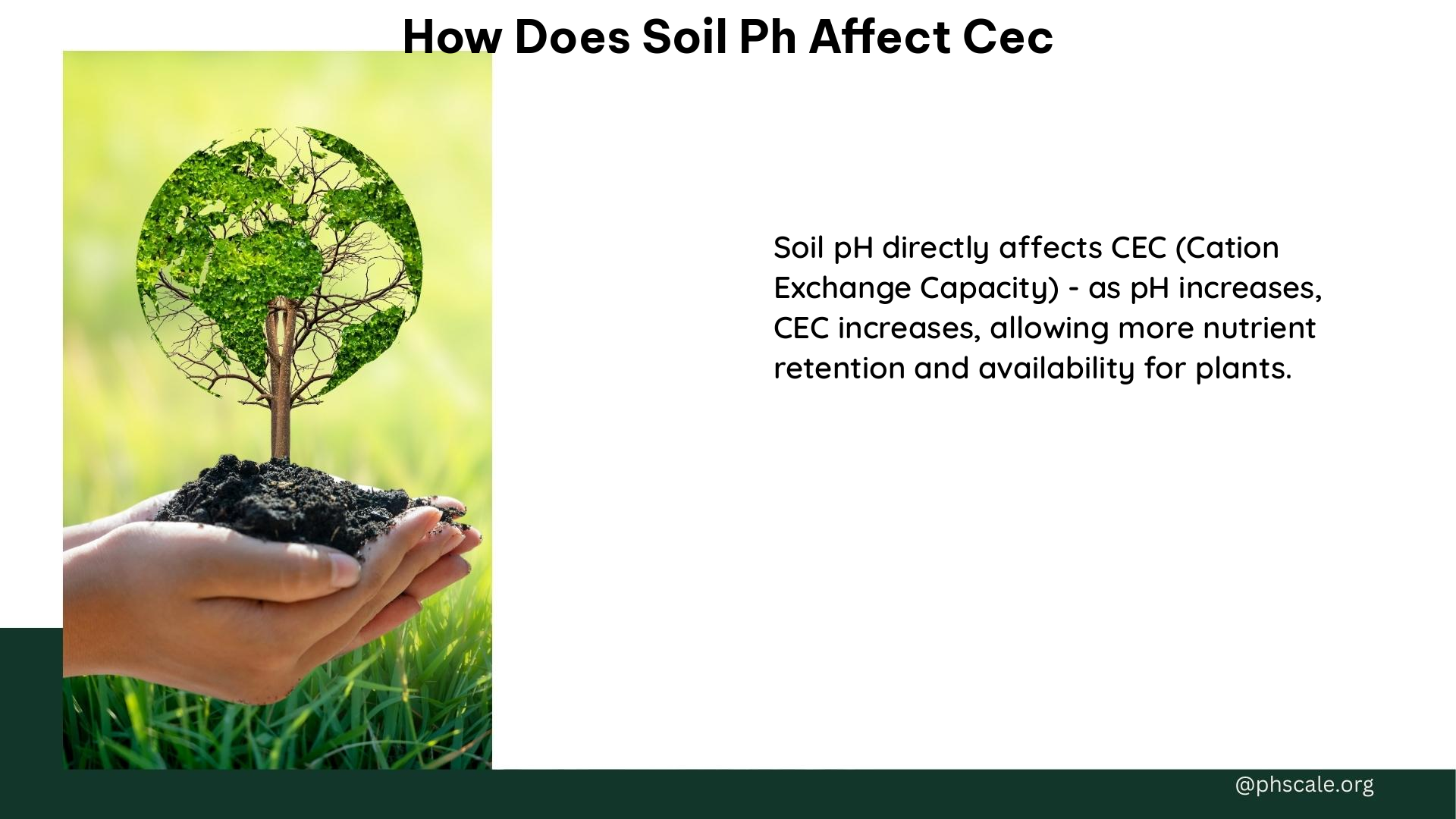Soil pH has a significant impact on the Cation Exchange Capacity (CEC) of a soil. As soil pH increases, the number of negative charges on soil colloids increases, leading to a higher CEC. This relationship between soil pH and CEC is crucial for understanding and managing soil fertility and nutrient availability.
The Correlation Between Soil pH and CEC
-
Increasing pH, Increasing CEC: As soil pH increases (becomes less acidic), the number of negative charges on soil colloids, such as clay minerals and organic matter, increases. This increase in negative charges leads to a higher CEC, as the soil can now hold more positively charged cations.
-
pH Influence on CEC: The CEC of soil organic matter and some clay minerals varies with pH. Generally, CEC is lowest at soil pHs of 3.5 to 4.0 and increases as the pH is increased by liming an acid soil.
-
Effect of pH on Cation Exchange: At low pH (acidic soils), hydrogen ions (H+) displace other exchangeable cations from the soil, reducing CEC. At high pH (basic soils), hydroxide ions (OH-) remove H+ ions from the hydroxide groups in clay, increasing the negative charge and CEC.
Typical CEC Ranges and Soil Types

The CEC of a soil can vary depending on the soil type and pH. Here are some typical CEC ranges for different soil types:
| Soil Type | CEC Range (meq/100g) |
|---|---|
| Light colored sands | 3-5 |
| Dark colored sands | 10-20 |
| Light colored loams and silt loams | 10-20 |
| Dark colored loams and silt loams | 15-25 |
| Dark colored silty clay loams | 30-40 |
| Organic soils | 50-100 |
As you can see, soils with higher organic matter and clay content generally have higher CEC values, while sandy soils tend to have lower CEC.
Impact of Soil pH on Nutrient Availability
Soil pH not only affects CEC but also influences the availability of various nutrients for plant growth. Here’s how soil pH can impact nutrient availability:
-
Nitrogen: Nitrogen is most available to plants at nearly neutral pH levels (around pH 6.5-7.0).
-
Phosphorus: Phosphate ions are available in weakly acidic soil (pH 6.0-6.5) but are removed at low pH as insoluble aluminum phosphate and at high pH as insoluble calcium phosphate.
-
Calcium and Magnesium: These nutrients are less available in acidic soils (low pH) but become more available as the pH increases.
-
Micronutrients: The availability of micronutrients, such as iron, manganese, boron, and copper, is generally higher in acidic soils but can become limited in alkaline (high pH) soils.
Practical Implications for Soil Management
Understanding the relationship between soil pH and CEC is crucial for effective soil management and crop production. Here are some practical implications:
-
Fertilization Practices: Soils with high CEC can retain more nutrients than low-CEC soils, requiring different fertilization strategies to ensure optimal nutrient availability.
-
Liming Practices: Liming an acidic soil can increase the pH, which in turn increases the CEC and the availability of certain nutrients, such as calcium and magnesium.
-
Crop Production: Crop production can release acidity into the soil, causing the pH to decrease more on low-CEC soils. Monitoring and adjusting the soil pH is essential for maintaining optimal nutrient availability and plant growth.
In conclusion, soil pH has a direct and significant impact on the Cation Exchange Capacity (CEC) of a soil. Understanding this relationship is crucial for effective soil management, nutrient availability, and crop production.
References:
- Purdue University Cooperative Extension Service. (n.d.). Fundamentals of Soil Cation Exchange Capacity (CEC). Retrieved from https://www.extension.purdue.edu/extmedia/ay/ay-238.html
- Soil Quality. (n.d.). Cations and Cation Exchange Capacity. Retrieved from https://www.soilquality.org.au/factsheets/cation-exchange-capacity
- YouTube. (2014). E.12.3 Discuss the effects of soil pH on cation-exchange capacity and availability of nutrients. Retrieved from https://www.youtube.com/watch?v=fSmk9ZZKujo
- University of Georgia Extension. (2014). Cation Exchange Capacity and Base Saturation. Retrieved from https://extension.uga.edu/publications/detail.html?number=C1040&title=cation-exchange-capacity-and-base-saturation
- The Lawn Forum. (2022). CEC and pH Correlation. Retrieved from https://www.thelawnforum.com/threads/cec-and-ph-correlation.36762/
